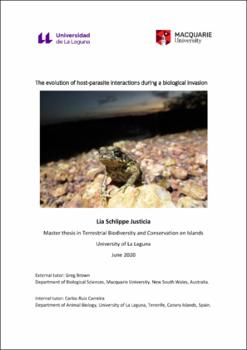The evolution of host-parasite interactions during a biological invasion
Author
Schlippe Justicia, LiaDate
2021Abstract
Hosts and parasites are in a perpetual co-evolutionary “arms race” that might be affected during
a biological invasion, where both host and parasite are exposed to powerful new selective
forces. The cane toad (Rhinella marina) invasion in Australia provides a unique opportunity to
study the initial stages by which hosts and parasites adapt to each other in novel environments.
To explore this issue, we raised the offspring of cane toads from three regions across its invasion
range under standard conditions, and used reciprocal cross-infection experiments with
lungworm nematodes (Rhabdias pseudosphaerocephala) to clarify geographical coevolution
between toad fitness measures and parasite infectivity. Our results show rapid shifts in hostparasite interactions during a biological invasion. Whereas parasites evolved higher infectivity
close to the invasion front, hosts seem to develop rapid specific resistance to co-evolved
parasites after separation by a few generations. Indeed, our results suggest a parasite local
maladaptation (i.e., local adaptation of hosts to parasites). Importantly, we found that the main
mechanism of toad resistance to infection is prevention of the worms reaching and establishing
in the lungsrather than immune reaction once worms have reached the lungs. No major impacts
on cane toad fitness measures were found during the lungworms migrations through the
metamorphs bodies, though negative impacts could appear once they are established in the
lungs.




